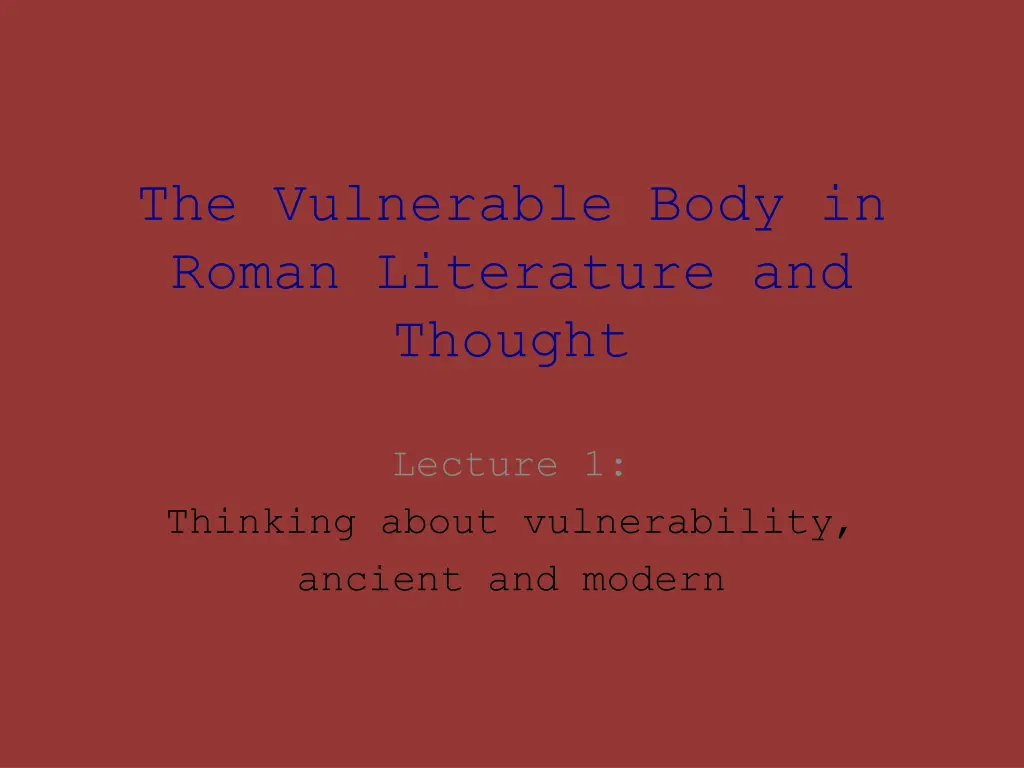
Understanding Vulnerability in Roman Literature and Thought
Explore the concept of vulnerability in ancient and modern contexts through the lens of Roman literature and thought. Delve into questions on the normativity of vulnerability, societal perceptions, and the role of gender in shaping notions of vulnerability. Reflect on the human subject, bodily integrity, and the relational nature of the vulnerable self.
Download Presentation

Please find below an Image/Link to download the presentation.
The content on the website is provided AS IS for your information and personal use only. It may not be sold, licensed, or shared on other websites without obtaining consent from the author. If you encounter any issues during the download, it is possible that the publisher has removed the file from their server.
You are allowed to download the files provided on this website for personal or commercial use, subject to the condition that they are used lawfully. All files are the property of their respective owners.
The content on the website is provided AS IS for your information and personal use only. It may not be sold, licensed, or shared on other websites without obtaining consent from the author.
E N D
Presentation Transcript
The Vulnerable Body in Roman Literature and Thought Lecture 1: Thinking about vulnerability, ancient and modern
Opening questions How normal, or normative, is vulnerability, now, as in the ancient world? To what extent is Greco-Roman antiquity constructed in the modern imagination around representation of perfect, beautiful bodies? What is at stake in emphasizing the normality or ubiquity of vulnerability, rather than imagining vulnerability as marking certain bodies in their difference from the healthy, upright, self-sufficient,
Does vulnerability in others elicit our sympathy, or also our disgust? Is it beautiful, or ugly, or both? Why? Do those views change as we get older? To what extent is vulnerability associated with shame in our culture? Or even with other kinds of weakness moral, ethical, legal? Is vulnerability gendered?
The hu-man subject Free - Adult - Impenetrable - Invulnerable - vulnerable Non-dependent - Western Eastern/foreign/other Male gendered enslaved child penetrable dependent female/ambiguously
The (ancient Roman) principle of bodily integrity M.Nussbaum, Women and Human Development (1999) The top 10 human capabilities : #3 = The ability to move freely from place to place, having one s boundaries treated as sovereign, i.e., to be able to secure against assault, including sexual assault, child sexual assault and domestic violence.
Butler, Precarious Life, 2004 We cannot, however, will away this vulnerability. We must attend to it, even abide by it (P.29)
In its radical openness, the vulnerable subject is always encountering and being encountered, moving towards and being moved by others. In that sense, the context where embodied selves move through cannot be reduced either to the rational mind moving the body or the body moving the mind, as dualistic epistemologies would argue. Instead, the embodied self is relational, for better or for worse. Urquiza Haas and Arturo S nchez Garc a. Conference Proceedings
Vulnerable bodies in Latin lit The torn, wounded, frightened warrior The soft elegiac lover Satire s bloated, abject bodies Lucan s losers The abandoned, suicidal heroine The tragic victims
Are explorations of vulnerability germane to discourses of EMPIRE? Or: To what extent does making a spectacle of vulnerability sustain invulnerability as an ideal or fantasy?
Our vulnerable writers/ writers of vulnerability Horace, 65-8BCE, son of a freedman . Ovid,43BCE-c.17CE, ?darling? of Augustus, banished in 8CE Phaedrus, c.15BCE-50CE, the ex- slave/freedman Persius, c.34-62CE. (Friend of Seneca and Thrasea Paetus) Seneca the Younger, c.4-65CE; exiled by Claudius, forced to suicide by Nero Statius, 40/50-96CE.
